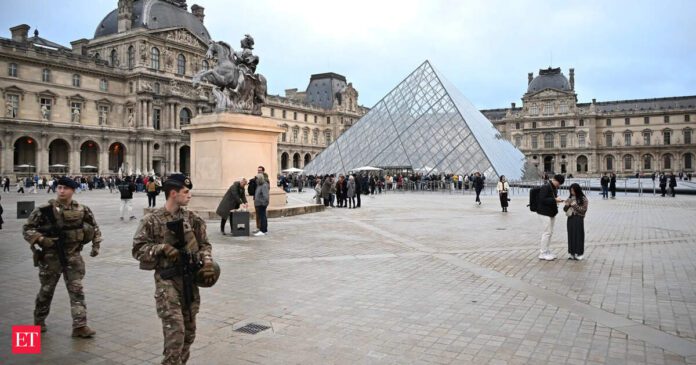The stolen items include a tiara, necklace, and earrings from the Queen Marie-Amélie sapphire set, an emerald necklace and earrings from the Empress Marie-Louise set, and several pieces belonging to Empress Eugénie de Montijo, including a tiara and a large bodice bow brooch.
Remarkably, the Crown of Empress Eugénie was dropped by the thieves during their escape and was later recovered outside the museum, albeit damaged
The heist, which lasted just seven minutes, was executed with military precision. Four masked thieves used a truck-mounted mechanical lift to access a first-floor window of the Galerie d’Apollon. They then employed power tools to breach display cases and absconded on motorbikes. Despite the rapid response of security personnel, the thieves managed to evade capture.
Authorities are now grappling with the grim possibility that the stolen jewels may be dismantled or melted down. Experts and historians warn that the thieves are likely to break up the pieces, melt down the valuable metals, and recut any identifiable stones to erase traces of their origin.
According to USA Today website, Erin Thompson, a professor of art crime at John Jay College of Criminal Justice, said thieves who carry out this sort of robbery usually take apart or melt down the conspicuous items “as soon as possible, within hours,” to reduce the risk of being caught. While that lowers their historical value, it also makes the pieces much harder to trace back to the museum.The investigation is being led by the BRB, a specialized police unit experienced in handling high-profile thefts.Former French police officer Pascal Szkudlara concurs, noting that such high-value thefts often lead to the rapid dismantling of the loot to facilitate untraceable resale. He adds that while the thieves may be apprehended, recovering the jewels in their original form is unlikely.
“They can have teams working on it 24/7 and for a long period,” Szkudlara said, expressing “100 percent” confidence the thieves would be caught.
France has ordered a comprehensive security audit at the Louvre, which welcomed 8.7 million visitors last year, and promised to enhance security at other cultural landmarks. Justice Minister Gérard Darmanin told France Inter that officials “failed” to adequately protect the “priceless” jewelry.
The Louvre said in a statement, “Beyond their market value, these items have inestimable heritage and historical value.”

